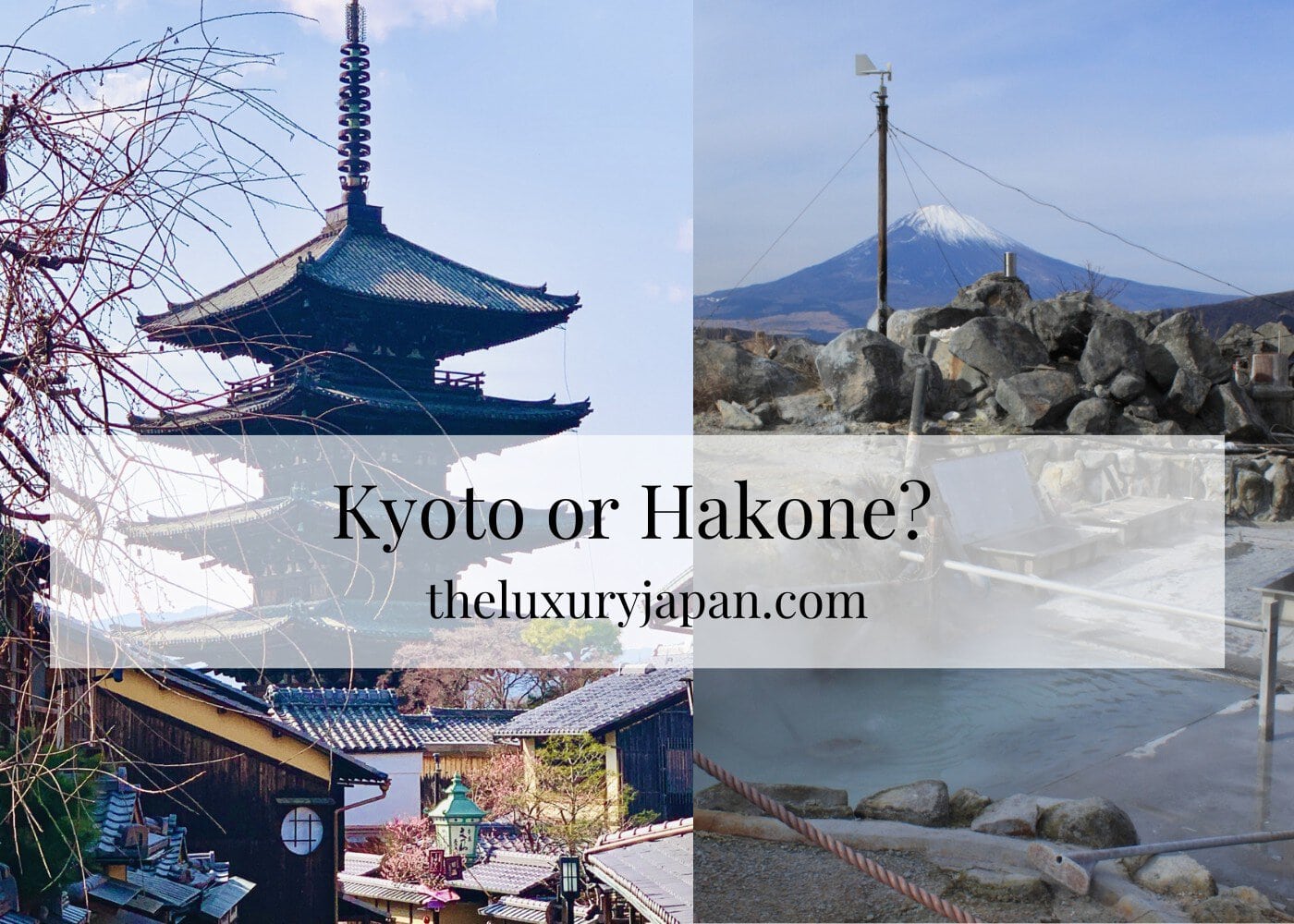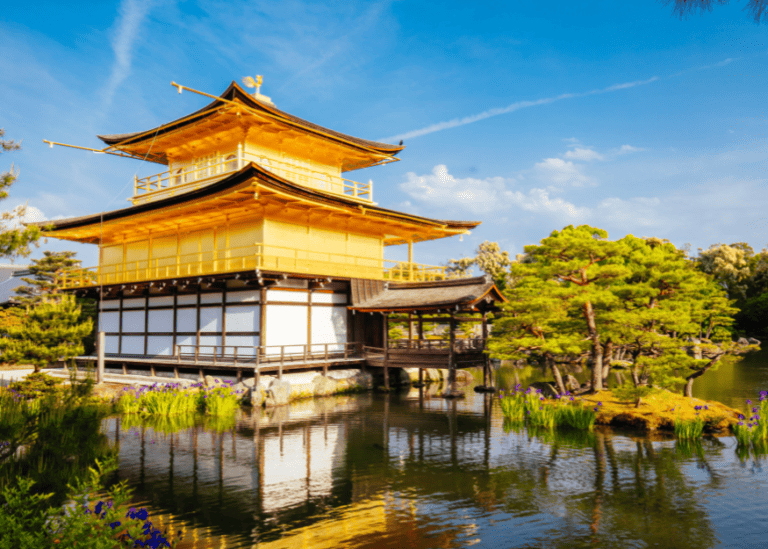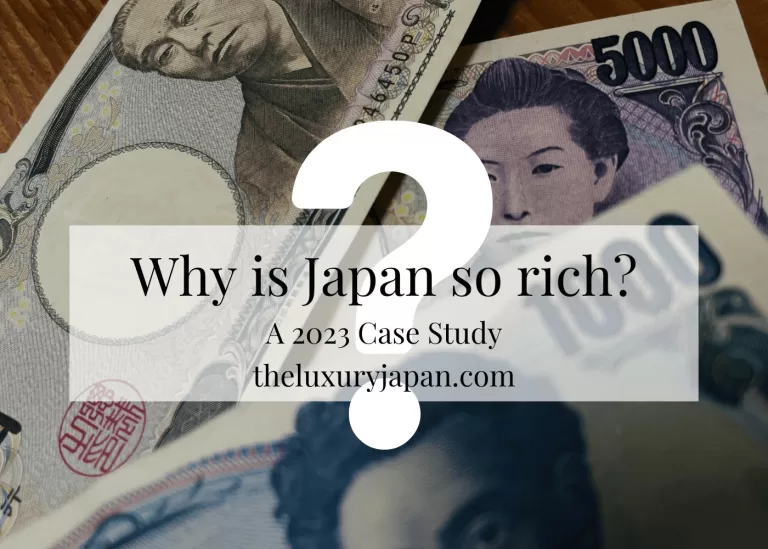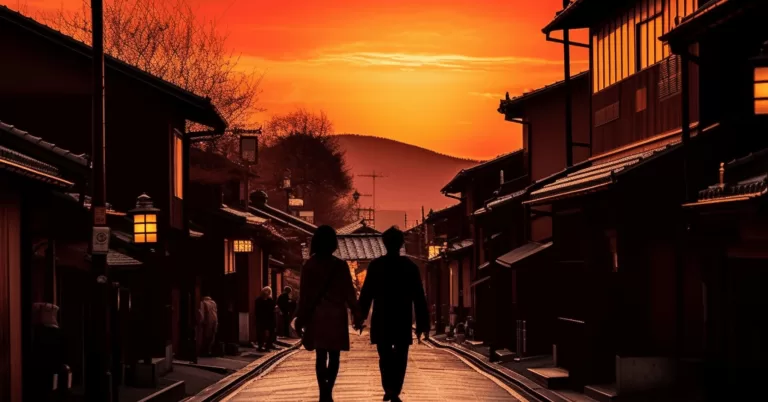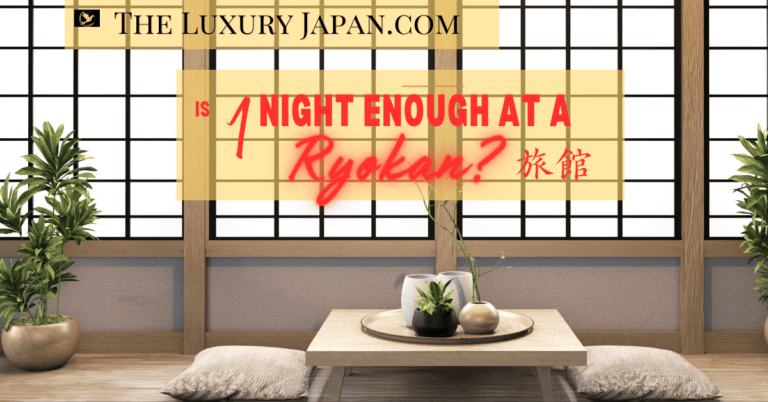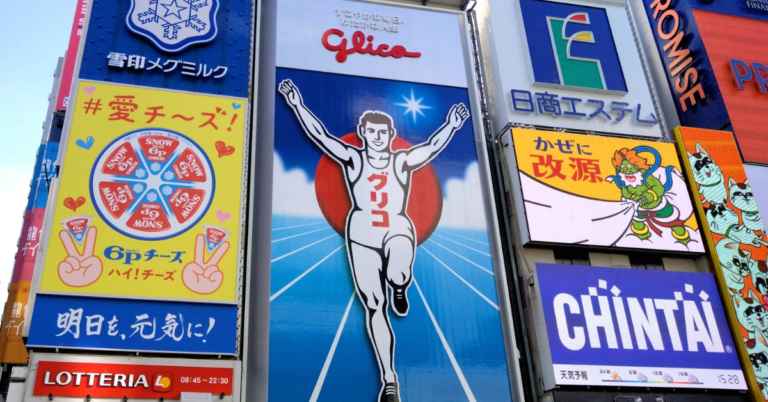Kyoto or Hakone – A Detailed Comparison Guide in 2024
Kyoto and Hakone are two of the most popular traditional places in Japan. Kyoto is known to provide the best cultural experiences whereas Hakone will take your breath away by the stunning nature. Both places have become famous tourists and choosing between Hakone and Kyoto can be quite challenging.
As a local Japanese who has visited both Kyoto and Hakone for several times since I was young, I believe both are must-visits. But if you need more resources to go to both locations and are trying to find the one you’ll enjoy, I have provided a detailed comparison guide in this article to help you pick the city that suits you better.
If you don’t have time to read, here is a quick summary of how to decide if you should go to Kyoto or Hakone:
If you want to visit Japan’s most famous shrines and tourist spots, including UNESCO world heritages, and get to know Japanese history and culture, visit Kyoto. For nature lovers, laidback and slow travelers, Hakone’s hot springs and views of Mount Fuji then Hakone should be your choice.
In terms of length of stay, visiting Kyoto would require at least four full days of itinerary while Hakone could be explored in a day or two. From Tokyo, Hakone is around 2,500 Japanese yen and can be reached in around 1.5 hours via Romance Car. Going to Kyoto from Tokyo would either be by bullet train (12,500 Japanese yen, 2.5 hours) or a bus (More than 10 hours, ranges from 3900 to 7900 Japanese yen).
Kyoto – Former Capital of Japan
Kyoto is known as the hub of Japanese culture. If you are interested in the culture of Japan and want to learn more about its traditions and people, then Kyoto is an excellent place to visit. Kyoto is the treasure of Japanese shrines, temples, and even palaces.
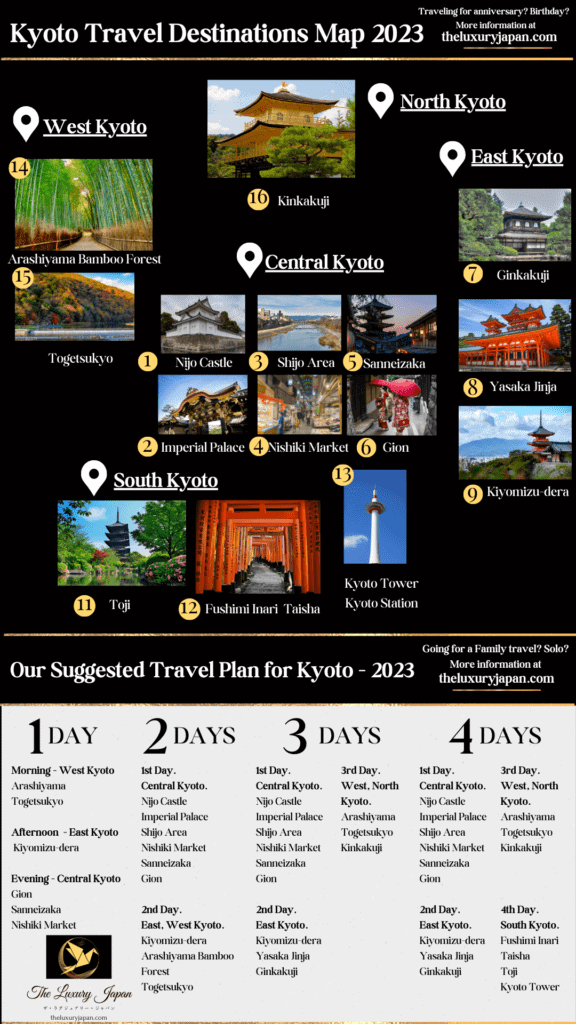
Kyoto is the home of the historical sites of Japan, and this is the heart of Japan, where you can learn a lot about the past, the culture, and the religion of the people of Japan. There are about 1600 temples here, considered one of Japan’s most popular tourist spots.
Note that Kyoto was a former capital of Japan for more than 1000 years so you will find a lot of Japanese artifacts in this city.
Hakone – Japanese Countryside
If you are interested in the countryside view and want to glimpse Mount Fuji, you must visit Hakone. There are so many fun activities you activities in Hakone that will surely make your stay much more fun and memorable. From boiled black eggs to bubbling hot springs, to the finest outdoor art galleries, and even other outdoor activities Hakone is undoubtedly a place to visit if you are coming to Japan.
Hakone is regarded as one of Japan’s most popular onsen spots so if you like to experience traditional Japanese hot spring and bathing facilities.
Kyoto or Hakone: Staying in a Ryokan
Ryokan, or traditional Japanese inn, is also a big topic when it comes to deciding between Kyoto or Hakone.
Kyoto: Luxury Ryokans, Traditional Japanese Architecture with Historical Touch
Staying in a ryokan in Kyoto offers an immersive experience of Japanese culture with historical touch, perfect for travelers interested in traditional Japanese architecture and exploring ancient temples.
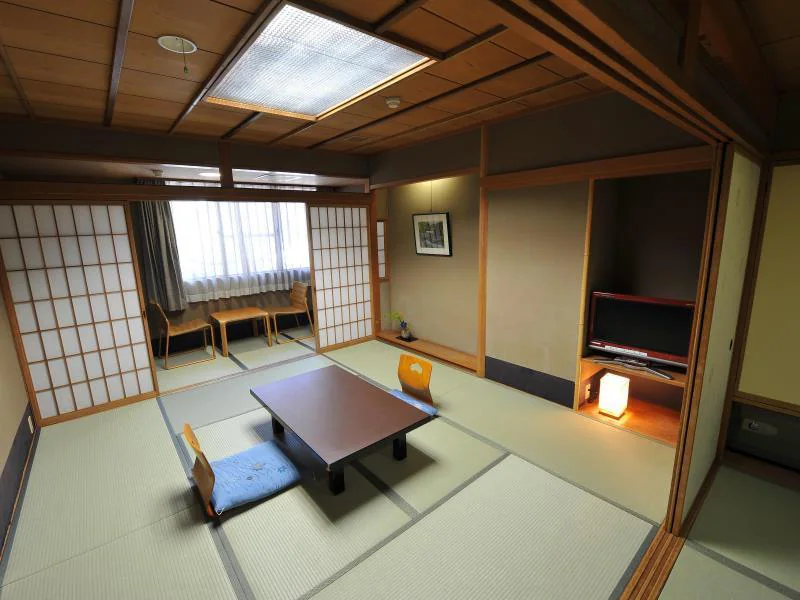
There are also a lot of affordable yet luxurious ryokans in Kyoto like Nanzenji Kyoto (for ryokans with private onsen) and Watazen (a more affordable option) which are perfect for travelers who are celebrating anniversaries or planning to do some unique honeymoon experiences in Japan.
Hakone: Ryokan with Private Onsen
On the other hand, a ryokan in Hakone provides a serene retreat with hot springs and stunning views of Mount Fuji, ideal for nature lovers seeking relaxation. Kyoto suits history buffs and those keen on city exploration, while Hakone is better for those wanting to unwind in a natural setting. Each city offers a unique slice of Japan, catering to different traveler preferences.
Kyoto or Hakone: What to Expect and Things to do
Here is a brief summary of must-do things in both Kyoto and Hakone:
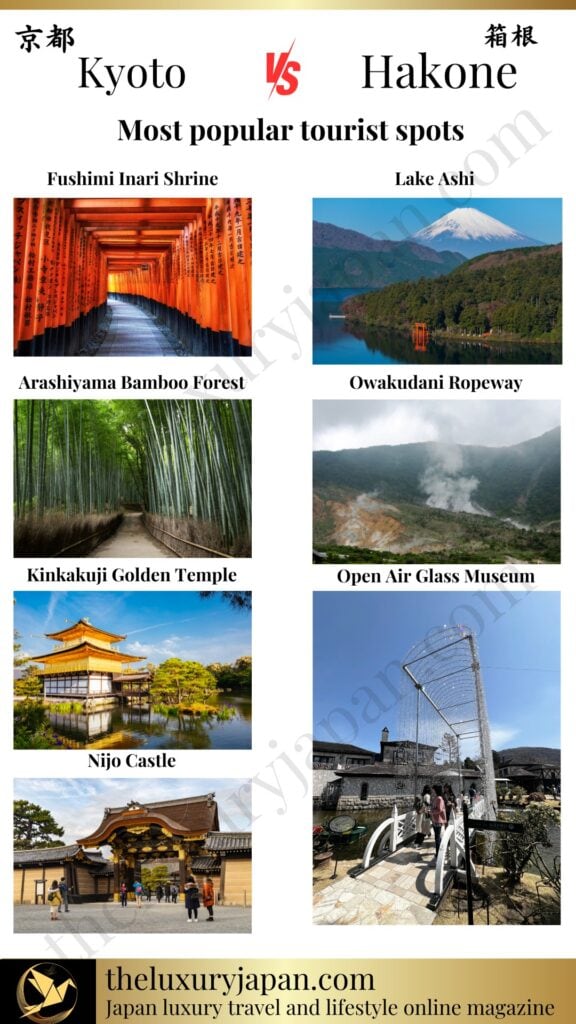
Kyoto: History Buffs, Culture Enthusiasts, Tourists of All Types
Kyoto attracts those fascinated by history and traditional Japanese culture. With its ancient temples, traditional tea houses, and vibrant markets, it’s a haven for culture enthusiasts. The city’s charm lies in its well-preserved heritage and serene ambiance, making it a favorite among tourists of all ages.
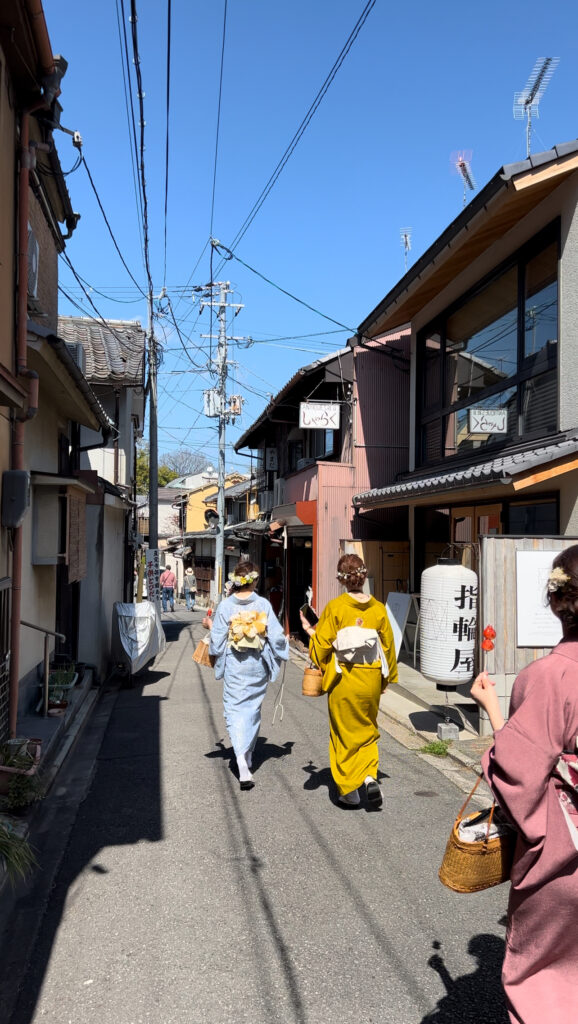
Kyoto also offers a plethora of activities centered around its historical and cultural sites. Tour the iconic Fushimi Inari Shrine, stroll through the Arashiyama Bamboo Grove, and explore the traditional Gion district, known for its geisha culture and historic architecture.

Hakone: Relaxation, Nature Lovers
Hakone is the go-to destination for those seeking relaxation in nature. The serene environment, combined with the beautiful views of Mount Fuji and the calming hot springs, makes it ideal for couples and families looking for a peaceful and laidback retreat. The vibe in Hakone is laid-back, perfect for unwinding and escaping the hustle and bustle of daily life.
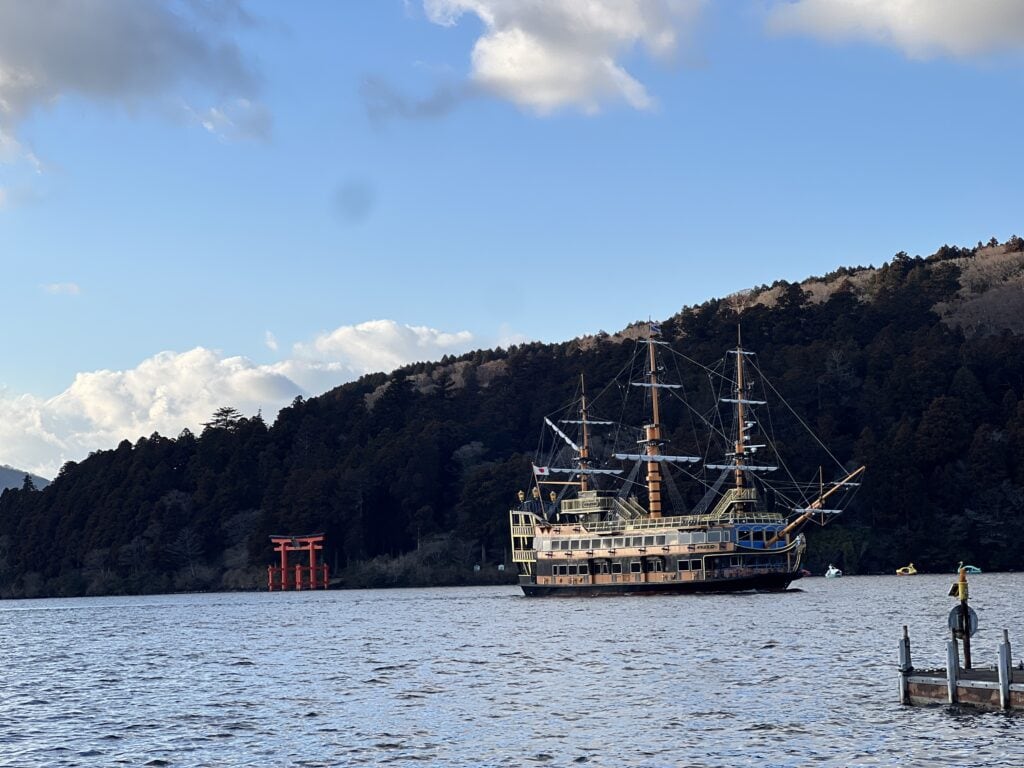
Hakone is also a very mountainous area; this is why it is the perfect destination for people who want a retreat in the hustling cities and want to visit a simple and quiet place. There is the Hakone ropeway, one of Hakone’s most popular attractions. If you get a clear day, you can see beautiful views of Mount Fuji. Hakone is also known for its open-air museum, and it also has hot springs.
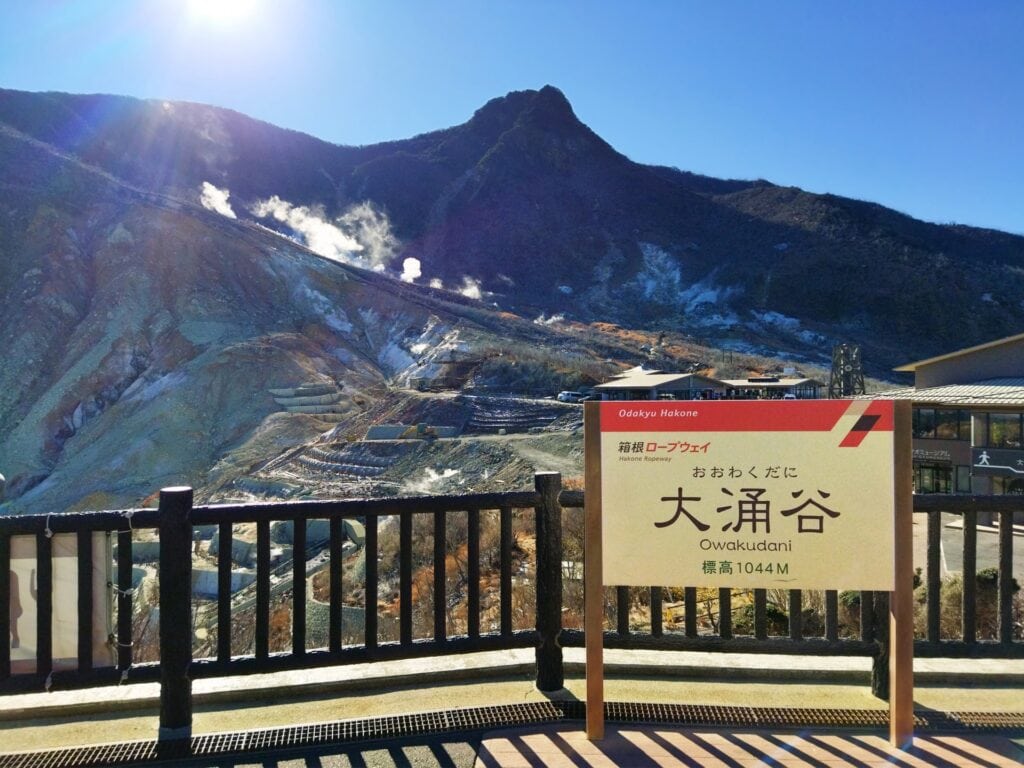
Things to do Winner: Kyoto
Hakone is perfect for those who prioritize relaxation and natural beauty, while Kyoto caters to history buffs and culture lovers. Choose Hakone for a nature escape and Kyoto for a deep dive into Japan’s rich cultural heritage. You will never run out of things to do in Kyoto! Kyoto has more unique things to do than Hakone because of its richer history preservations.
Witnessing Japanese Culture
Kyoto: High (Temples, Shrines, Traditional Arts, Tea Ceremonies)
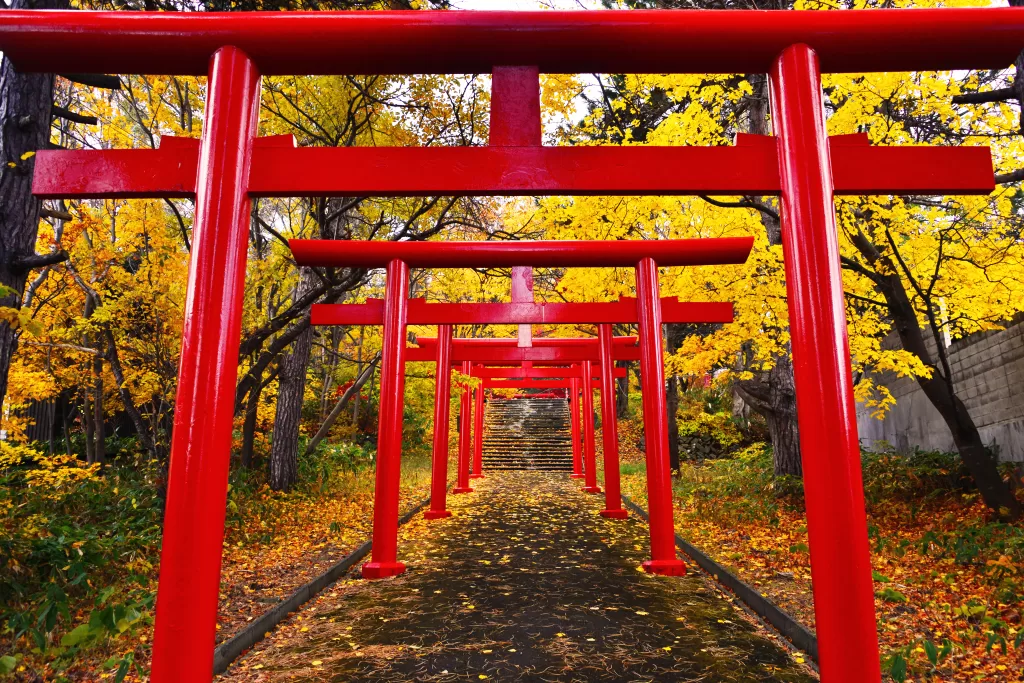
Hakone: Moderate (Onsen Culture, Local Crafts)
In Hakone, you can experience Japanese culture through its famous onsen (hot springs) and local crafts. The onsen culture is deeply ingrained, offering a unique way to relax and rejuvenate. Visiting the open-air museums and craft shops gives a glimpse into the region’s artistic side.
Witnessing Japanese Culture Winner: Kyoto
For a deep Japanese cultural experience, Kyoto outshines with its rich history and traditional practices. Hakone offers a more relaxed, nature-oriented cultural experience.
Day Trip Options
Hakone: Odawara Castle, Gotemba, Mount Fuji
From Hakone, you can easily visit Odawara Castle, explore the shopping outlets at Gotemba, or take a day trip to see the iconic Mount Fuji up close.
Kyoto: Nara, Osaka, Uji, Himeji
Kyoto’s central location makes it an ideal base for day trips to nearby cities. Visit Nara’s famous deer park, explore the bustling city of Osaka, enjoy the tea culture in Uji, or marvel at Himeji Castle.
Exploring Kansai (the region where Kyoto, Nara, Osaka belong to) alone would already take at least ten to fourteen days of travel.
Day Trip Options Winner: Kyoto
Kyoto’s proximity to other historically rich and vibrant cities offers more diverse day trip options compared to Hakone.
Food Options
Kyoto: Kaiseki Dining, Street Food, Nishiki Market, Tea Houses
Kyoto excels in culinary diversity, from luxurious kaiseki dining to vibrant street food markets. Nishiki Market is a must-visit for food lovers, and the city’s tea houses provide a serene spot to enjoy matcha and traditional sweets.
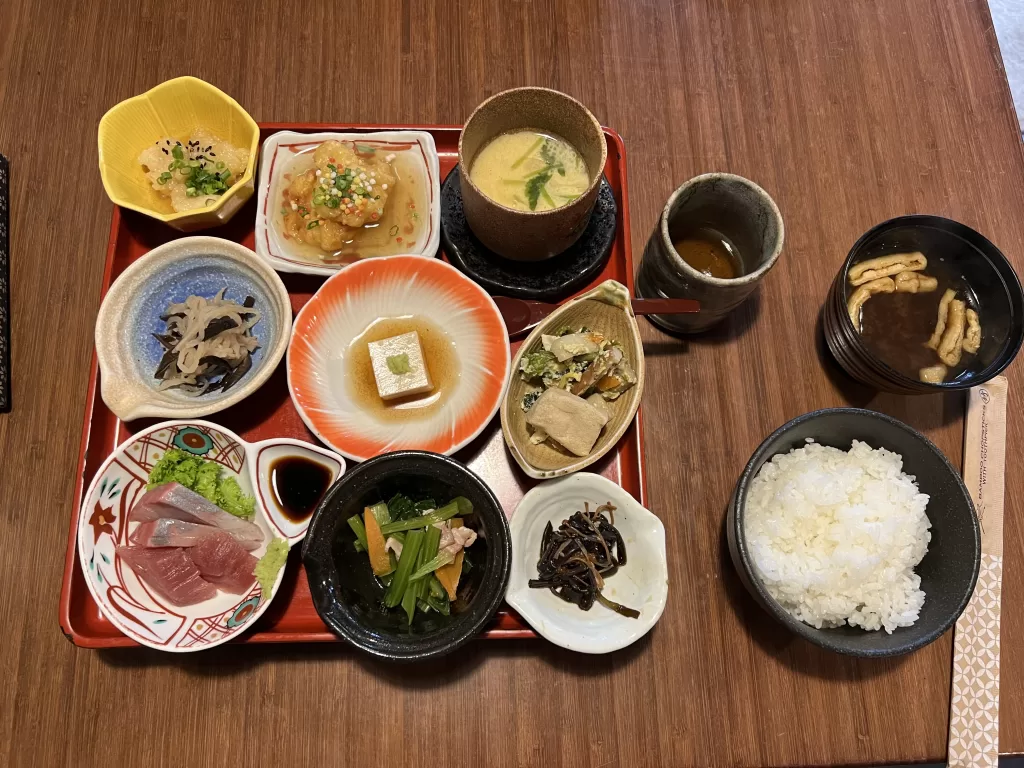
Exploring Matcha cafes is also one of my favorite activities when in Kyoto. Especially when going to Nakamura Tokichi Honten which is the best matcha cafe in Kyoto. If you are visiting Kyoto whether you are a foodie or not, this place is a must-visit.
I personally had been to Kyoto many times and had always ignored the little town of Uji but I was astounded and was impressed not only because of its rich history but also with the food and souvenir shopping. Uji is a quick and easy day trip from Kyoto and I highly recommend alloting a day to visit it. Uji is considered as the Matcha capital of Japan but then again, whether you are a Matcha lover or not, this is a must-visit little town.
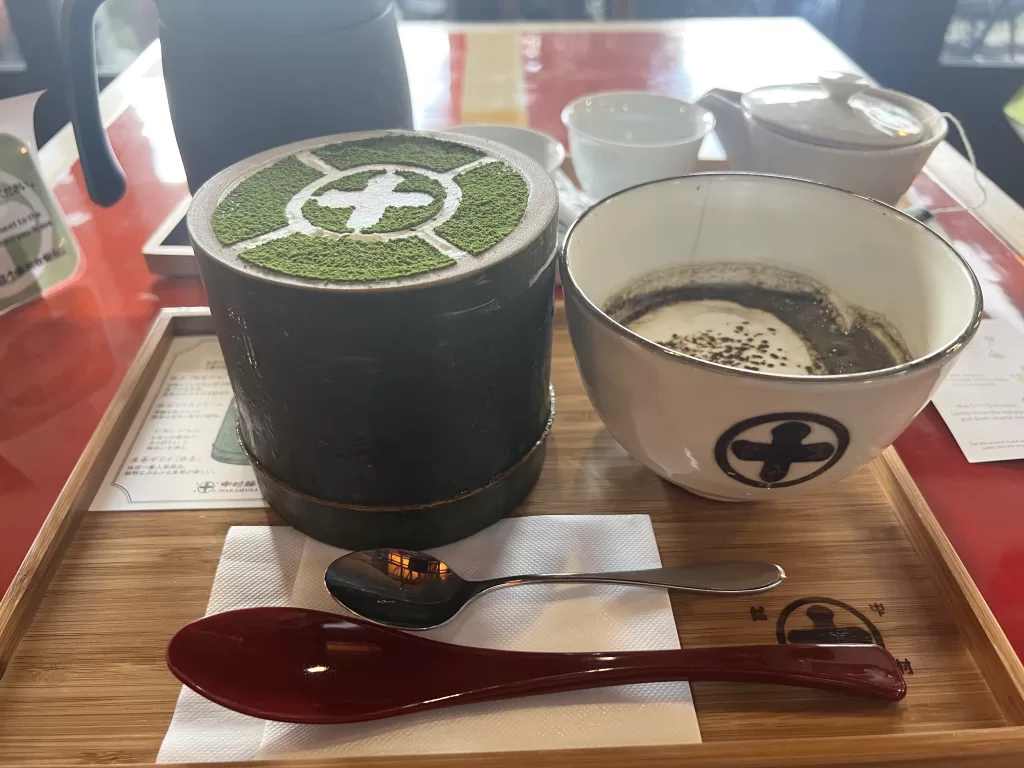
Aside from Matcha cafes, of course, dessert cafes also are very popular in Kyoto. Umezono Matcha Cafe is another favorite of mine that I make sure to visit when I am in Kyoto.
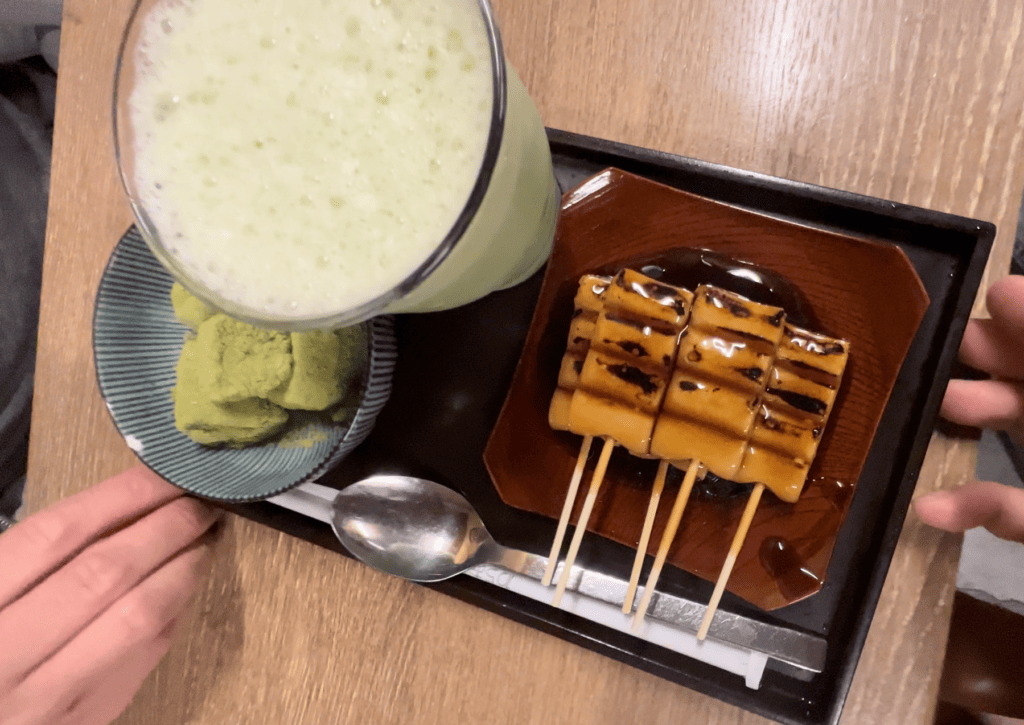
Hakone: Traditional Ryokan Meals, Seafood, Local Specialties, Cafes
Hakone’s food scene revolves around traditional ryokan meals, offering a taste of authentic Japanese cuisine. Local specialties and quaint cafes add to the culinary experience.
Seafood is very popular in Hakone because of its big lake. In fact, one of the most traditional Hakone food is Wakasagi (a fish that can be found in Hakone)
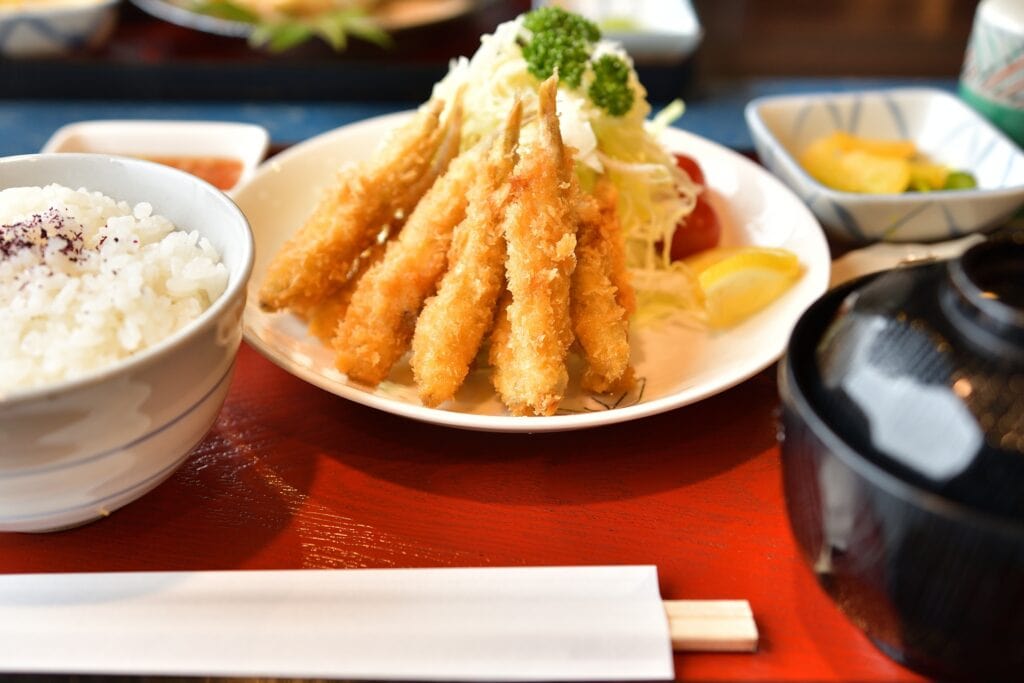
Food Options Winner: Kyoto
Indeed, when you are choosing either to go to Kyoto or Hakone, one of the most important things to consider is food options. You do not want to be in a place where it has probably 80% seafood, as in the case of Hakone.
In Kyoto, there are matcha cafes, kaiseki restaurants, Michelin-starred restaurants, and restaurants with Tofu specialties.
Accessibility and Transportation
Hakone: Accessible via Train (Odakyu Line), Buses, Easy to Navigate
Hakone is easily accessible by train from Tokyo via the Odakyu Line, with buses and local transportation making it easy to navigate the area. The compact layout allows for convenient exploration.
Kyoto: Well-Connected by Train and Bus, Easy to Explore on Foot
Kyoto boasts excellent connectivity, with a comprehensive train and bus network, although still not comparable to Tokyo (of course!).
The JR Sagano Line, for instance, quickly gets you from Kyoto Station to the Arashiyama Bamboo Grove in about 15 minutes. City buses are frequent and cover almost every corner of Kyoto, including major sites like Kinkaku-ji (the Golden Pavilion) and Fushimi Inari Shrine. The one-day bus pass is a practical choice for tourists, offering unlimited rides for a reasonable price. Additionally, many of Kyoto’s key attractions are within walking distance of each other. For instance, you can easily walk from the historic Gion district to the serene Kiyomizu-dera Temple, enjoying the city’s atmosphere along the way.
Accessibility and Transportation Winner: Kyoto
Kyoto wins for its extensive and efficient public transportation system. With well-connected trains, frequent buses, and walkable routes between many attractions, navigating the city is straightforward and convenient. While Hakone is also easy to explore, the variety and frequency of Kyoto’s transport options give it a slight edge.
Luxury things to do
Kyoto: Private Temple Tours, Luxury Kaiseki Dinners, Tea Ceremonies
Kyoto’s luxury experiences are deeply rooted in its rich cultural heritage. Here are some highlights:
- Private Temple Tours: Gain exclusive access to some of Kyoto’s most historic temples and gardens. Tours like those offered by Shunkoin Temple provide personalized experiences where you can explore beautiful grounds and even participate in meditation sessions.
- Luxury Kaiseki Dinners: Enjoy exquisite kaiseki meals at top-rated restaurants such as Kikunoi or Hyotei. These multi-course dinners are a culinary journey through seasonal ingredients, meticulously prepared and artfully presented.
- Tea Ceremonies: Participate in a private tea ceremony at places like Camellia Tea Ceremony. This experience offers a serene and intimate glimpse into the traditional Japanese tea culture, complete with delicate sweets and the finest matcha tea.
Hakone: Private Onsens, Luxury Ryokans, Spa Treatments
In Hakone, luxury is all about relaxation and indulgence amidst natural beauty. Here are some top-tier experiences:
- Private Onsens: Many high-end ryokans (traditional Japanese inns) offer private onsen baths with stunning views of Mount Fuji or serene forest settings. For instance, Gora Kadan and Hakone Kowakien Ten-yu are known for their luxurious private onsen facilities.
- Luxury Ryokans: Staying in a luxury ryokan like Hakone Suishoen provides a blend of traditional Japanese hospitality and modern comforts. These establishments often include multi-course kaiseki dinners and breakfast, prepared with local ingredients.
- Spa Treatments: Pamper yourself with rejuvenating spa treatments at places like The Prince Hakone Lake Ashinoko. These spas offer a range of services from hot stone massages to aromatherapy, ensuring a blissful and relaxing experience.
Practical Tips:
- Kyoto: Reserve private tours and kaiseki dinners well ahead of time. Consider combining a private temple tour with a tea ceremony for a comprehensive cultural experience.
- Hakone: Book your private onsen or spa treatment in advance, especially during peak seasons. Look for ryokans that offer meal plans to fully enjoy the kaiseki dining experience.
Luxury Things to Do Winner: Tie
Both Hakone and Kyoto excel in providing unique luxury experiences. Hakone’s offerings focus on relaxation and rejuvenation, with private onsens and high-end spa treatments. In contrast, Kyoto’s luxury lies in its cultural elegance, offering exclusive temple tours, fine dining experiences, and traditional tea ceremonies. Each destination provides its own brand of luxury, making it hard to choose a definitive winner.
Budget Options
Kyoto: Budget Hostels, Inexpensive Street Food
Kyoto is a fantastic destination for budget travelers, with numerous options to save money while still enjoying the city’s rich culture. Here are some economical choices:
- Budget Hostels: Hostels like K’s House Kyoto and Piece Hostel Sanjo offer clean, comfortable, and affordable accommodations. Many hostels in Kyoto provide amenities like free Wi-Fi, communal kitchens, and social areas, making them a great base for exploring the city.
- Inexpensive Street Food: Kyoto’s street food scene is both delicious and affordable. Nishiki Market, for example, is a great place to sample local delicacies like yakitori (grilled chicken skewers), taiyaki (fish-shaped cakes filled with sweet red bean paste), and tempura. Many food stalls and small eateries offer tasty meals for just a few hundred yen.
Hakone: Affordable Guesthouses, Public Onsens
Hakone offers several budget-friendly options that allow you to enjoy the area without spending a fortune. Here are some top picks:
- Affordable Guesthouses: Guesthouses like K’s House Hakone and Hakone Tent offer comfortable and affordable lodging with communal areas and shared kitchens, perfect for budget-conscious travelers. These places provide a cozy atmosphere and a chance to meet fellow travelers.
- Public Onsens: Public onsens such as Tenzan Onsen and Hakone Yuryo offer traditional hot spring experiences at a fraction of the cost of private facilities. These public baths are well-maintained and provide a genuine taste of Japanese onsen culture without the high price tag.
Practical Tips:
- Hakone: Look for guesthouses that offer kitchen facilities so you can prepare some of your own meals. This can significantly cut down on food costs. Also, consider purchasing a Hakone Freepass, which can save money on transportation and entrance fees to various attractions.
- Kyoto: Take advantage of hostel facilities like communal kitchens and laundry services to save on dining and laundry costs. Don’t miss the street food markets, which offer a variety of affordable meals and snacks. Additionally, consider renting a bicycle to explore the city economically.
Budget Options Winner: Kyoto
Kyoto comes out on top for budget travelers due to its extensive range of affordable accommodations and plentiful inexpensive food options. With numerous hostels and a vibrant street food scene, Kyoto makes it easy to experience the city without overspending. While Hakone offers budget-friendly guesthouses and public onsens, Kyoto’s broader variety of cost-saving options gives it the edge for those traveling on a budget.
For Couples: Honeymoon or Celebrating Anniversaries
Hakone: Romantic Ryokans, Private Hot Springs, Scenic Spots
Hakone is perfect for honeymooners and those celebrating anniversaries, offering romantic ryokans, private hot springs, and picturesque landscapes that create a magical atmosphere.
Kyoto: Romantic Walks, Traditional Tea Ceremonies, Scenic Spots
Kyoto’s romantic ambiance, with its beautiful gardens, traditional tea ceremonies, and historic sites, makes it an ideal destination for couples celebrating special occasions.
Honeymoon or Celebrating Anniversaries Winner: Tie
Both Hakone and Kyoto provide romantic settings for honeymoons and anniversaries, each with its unique charm.
Nightlife and Entertainment
Hakone: Quiet, Focus on Relaxation, Few Bars and Restaurants
Hakone’s nightlife is quiet and centered around relaxation, with a few bars and restaurants offering a low-key evening experience.
Kyoto: Traditional Performances, Bars, Nightlife in Gion
Kyoto offers more vibrant nightlife options, including traditional performances, a variety of bars, and the lively Gion district known for its entertainment.
Nightlife and Entertainment Winner: Kyoto
Kyoto’s more diverse and lively nightlife scene provides more options for evening entertainment compared to Hakone.
Things to Do for Young Adults
Hakone: Outdoor Activities, Scenic Spots, Museums
Young adults visiting Hakone can enjoy outdoor activities like hiking and boating, exploring scenic spots, and visiting unique museums.
Kyoto: Shopping, Cultural Experiences, Vibrant Markets
Kyoto offers plenty of activities for young adults, including shopping, engaging in cultural experiences, and exploring vibrant markets like Nishiki Market.
Things to Do for Young Adults Winner: Kyoto
Kyoto’s wide range of shopping, cultural, and market experiences makes it more appealing for young adults.
Slow Travel and Relaxation
Hakone: Hot Springs, Scenic Views, Peaceful Atmosphere
Hakone is an excellent destination for slow travel and relaxation. Its hot springs, scenic views, and peaceful atmosphere make it perfect for those looking to take their time and truly unwind. Visitors can enjoy leisurely strolls around Lake Ashi, relax in private onsens, and take in the stunning views of Mount Fuji at their own pace.
Kyoto: Historical Exploration, Cultural Immersion
While Kyoto offers numerous opportunities for slow travel through historical exploration and cultural immersion, it tends to be more bustling with tourists. The serene gardens and traditional tea houses offer moments of tranquility, but the overall pace can be more hurried compared to Hakone’s laid-back vibe.
Slow Travel and Relaxation Winner: Hakone
For a truly relaxing and unhurried experience, Hakone’s serene natural setting and abundance of hot springs make it the ideal destination for slow travel.
Outdoor Activities
Hakone: Hiking Trails, Scenic Spots, Outdoor Museums
Hakone is a paradise for outdoor enthusiasts. The region boasts numerous hiking trails with breathtaking views, scenic spots like Lake Ashi, and unique outdoor museums like the Hakone Open-Air Museum. It’s perfect for those who love to explore nature and enjoy outdoor activities.
Kyoto: Temple Gardens, Bamboo Groves, Urban Parks
Kyoto also offers outdoor activities, primarily centered around its temple gardens, bamboo groves, and urban parks. While these are beautiful and serene, the outdoor activities in Kyoto are more limited to cultural and historical settings rather than adventurous pursuits.
Outdoor Activities Winner: Hakone
Hakone’s diverse range of outdoor activities, from hiking to exploring scenic spots and outdoor museums, makes it the better destination for nature lovers and adventure seekers.
This comparison provides a detailed look at what Hakone and Kyoto offer, helping readers choose the destination that best suits their travel style and preferences.
Wrap Up
Hakone and Kyoto offer unique experiences for travelers. Hakone excels in relaxation, natural beauty, and outdoor activities with its hot springs, scenic views of Mount Fuji, and hiking trails. It’s ideal for those seeking a peaceful retreat and slow travel. Kyoto, on the other hand, is perfect for history buffs and culture enthusiasts, boasting ancient temples, traditional tea houses, and vibrant markets. Kyoto offers a rich cultural immersion with diverse culinary options and bustling day trips to nearby cities.
While Hakone wins for relaxation and outdoor adventures, Kyoto shines in depth and variety of Japanese culture. Whether you prefer a serene escape in nature or a deep dive into Japan’s heritage, both of these places are my favorite spots to visit which I also highly recommend.
